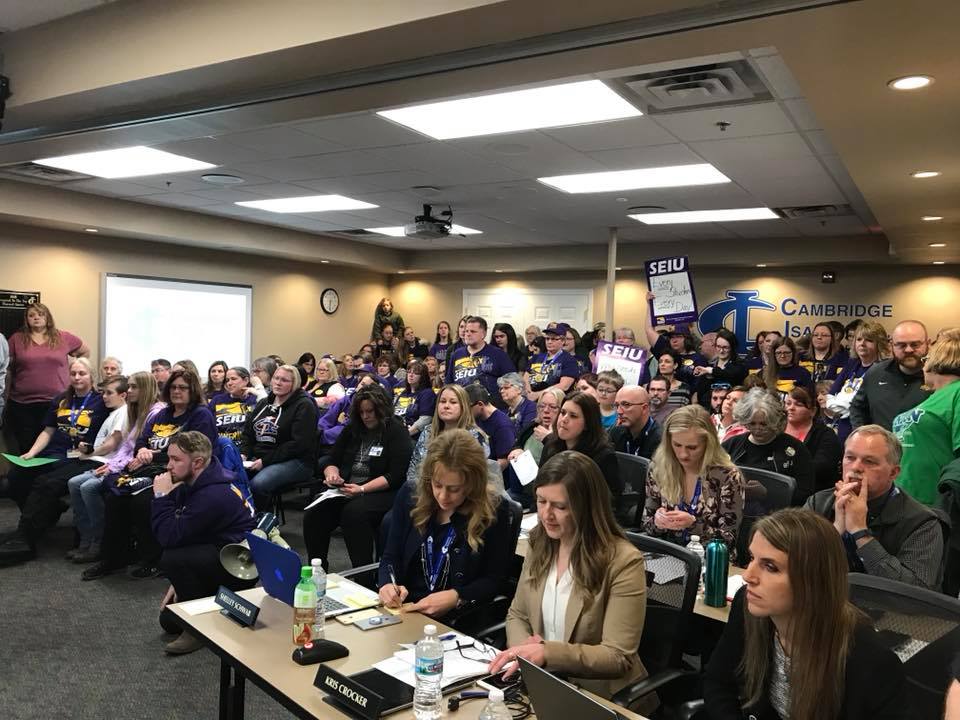

Share
This article was edited on April 13, 2019
Thursday night the Cambridge-Isanti Independent School District (ISD) 911 School Board voted to eliminate over 230 staff hours, per day, for special education paraprofessionals at seven schools. The result would be the loss of 50-60 special education paraprofessionals–over 25% of the workforce.
The board meeting saw an overflow, standing-room-only crowd of supporters demanding the Board not vote to make cuts to the most vulnerable students.

School staff and the community did not learn about this possible decision until last Friday, less than one week before the School Board could take this action. During the Board Meeting, the public was only given five minutes to testify about the damage that would be done by these cuts, causing further anger and frustration.
The district is about an hour north of the Twin Cities. In her fifth year as a special-ed paraprofessional with District 911, Melanie Custer explained that there aren’t many employment options for potentially displaced paras. According to publicly available documents, the school system is the largest employer in the district. Most other jobs are in retail.
Custer’s husband is a laborer earning irregular pay, so she will have to find another job if she is laid off. Custer doubts she would be able to find meaningful work quickly. She also pointed out that there are many young paras with children. For them the job is convenient. They are not forced to get expensive childcare because, “while they are working, their kids are at school.”
When she heard the news, Custer felt “confusion, anger, not feeling valued, wondering what’s gonna happen to the kids.” Custer, provides one-on-one support to students with special needs. She warns that any savings would come at a steep price for students, their families, and teachers in the district.
“Our students will suffer,” she said. “These are students with emotional and behavioral disorders, autistic students and students with learning disabilities. If you cut out the people who give them help, they are going to get lost in the system.”
Already, special-ed paras and the teachers they work alongside feel shorthanded. Custer wondered, “Are the teachers going to be totally stressed out and are they the next to leave?”
District Communications Coordinator Shawna Carpentier explained that the recommendation to the Board had been developed through a 2-year planning process.
“Each student IEP [Individual Education Plan] was reviewed to determine what they need.”
Carpentier further explained that the district is, “aligning our staffing with special education student needs.” She highlighted the possibility that these changes could result in more full-time positions because variable part-time hours will be eliminated.
Testifying before the vote, paraprofessionals and parents shared the harmful effects that special education cuts would have on students and the community.
buy proscar online proscar online no prescription
Talia Fluth, an Instructional Assistant at the schools and a parent of children who receive special education support service, spoke before the board voted to cut services to special needs students in the district.
“Ultimately, the needs of our students, my children, your children, is what is at stake when this decision is made. For the sake of our children’s future, my instructional assistant peers, and our community as a whole, I urge you to reconsider this layoff proposal,” said Fluth. “At the very minimum, we demand that this decision be postponed until members of the public and our education community can have more than six days to weigh in and share ideas on how this decision will impact the day-to-day education of our special needs students.”
Paraprofessionals are worried that the suddenness and depth of these cuts indicate that the district is on a path of mismanagement.
According to publicly available bond disclosures, enrollment regularly fluctuates at the Cambridge-Isanti school district with a notable decline in 2014.

The lower K-6 numbers compared to grades 7-12 suggest that enrollment will continue to decline.
Despite lowered enrollment and likely lowered revenue expectations, the district kept expanding.
buy spiriva online https://adamgrant.net/wp-content/uploads/2020/04/spiriva.html
online pharmacy https://www.fixdental.com.au/wp-content/uploads/gravity_forms/3-41e80f49ff6fc2d63561aa7a4b7803d7/2022/lariam.html no prescription pharmacy

Furthermore, according to data compiled by StartClass, “debt has more than quadrupled since 2001.”
The district claims that para cuts are not related to funding. However, the financial outlook will be a topic of conversation during upcoming contract negotiations between the district and SEIU 284 representing paraprofessionals.
Tara Valland, a para in the district and parent of a child with dyslexia, shared how important special education paras are for families in the community.
“I am afraid for our community and what might happen to all of our kids. My son has dyslexia, and it has been a struggle. After years of trying, we finally got a para for him, and he has gone from failing to A’s. He has gone from thinking college was out of reach to wanting to go to college!” Valland said. “Board members need to make sure every student is taken care of from Kindergarten to graduation. We want you to curb this decision until more information can be gathered by the community, teachers and, most important, parents in our district.”

For Nic Johnson, it is impossible to lose perspective on the impact of the Board’s decision since he is a para at the high school and was a recipient of special ed support. Speaking at the board meeting, he described why paras are so important in the community.
“I see kids just like me, and I know what they are going through,” said Johnson. “I just don’t know what is going on and what will happen if you make these cuts.”

